AMD Reveals Radeon VII: High-End 7nm Vega Video Card Arrives February 7th for $699
by Ryan Smith on January 9, 2019 1:00 PM EST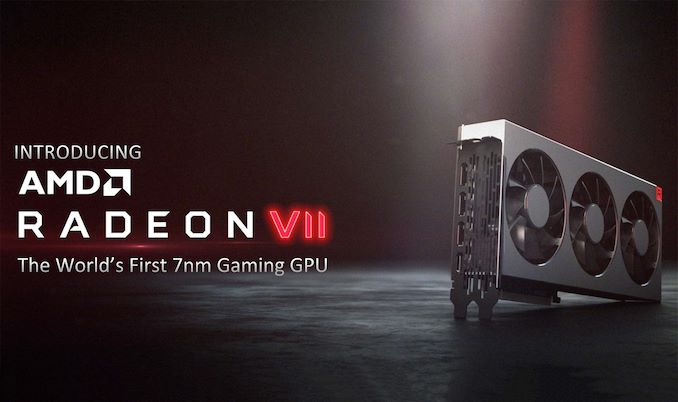
As it turns out, the video card wars are going to charge into 2019 quite a bit hotter than any of us were expecting. Moments ago, as part of AMD’s CES 2019 keynote, CEO Dr. Lisa Su announced that AMD will be releasing a new high-end, high-performance Radeon graphics card. Dubbed the Radeon VII (Seven), AMD has their eyes set on countering NVIDIA’s previously untouchable GeForce RTX 2080. And, if the card lives up to AMD’s expectations, then come February 7th it may just as well do that.
Today’s announcement is interesting in that it’s just as much about technology as it is the 3D chess that is the market positioning fights between AMD and NVIDIA. Technically AMD isn’t announcing any new GPUs here – regular readers will correctly guess that we’re talking about Vega 20 – but the situation in the high-end market has played out such that there’s now a window for AMD to bring their cutting-edge Vega 20 GPU to the consumer market, and this is a window AMD is looking to take full advantage of.
At a high level then, the Radeon VII employs a slightly cut down version of AMD’s Vega 20 GPU. With 60 of 64 CUs enabled, it actually has a few less CUs than AMD’s previous flagship, the Radeon RX Vega 64, but it makes up for the loss with much higher clockspeeds and a much more powerful memory and pixel throughput backend. As a result, AMD says that the Radeon VII should beat their former flagship by anywhere between 20% and 42% depending on the game (with an overall average of 29%), which on paper would be just enough to put the card in spitting distance of NVIDIA’s RTX 2080, and making it a viable and competitive 4K gaming card.
| AMD Radeon Series Specification Comparison | ||||||
| AMD Radeon VII | AMD Radeon RX Vega 64 | AMD Radeon RX 590 | AMD Radeon R9 Fury X | |||
| Stream Processors | 3840 (60 CUs) |
4096 (64 CUs) |
2304 (36 CUs) |
4096 (64 CUs) |
||
| ROPs | 64 |
64 | 32 | 64 | ||
| Base Clock | ? | 1247MHz | 1469MHz | N/A | ||
| Boost Clock | 1800MHz | 1546MHz | 1545MHz | 1050MHz | ||
| Memory Clock | 2.0Gbps HBM2 | 1.89Gbps HBM2 | 8Gbps GDDR5 | 1Gbps HBM | ||
| Memory Bus Width | 4096-bit | 2048-bit | 256-bit | 4096-bit | ||
| VRAM | 16GB | 8GB | 8GB | 4GB | ||
| Single Precision Perf. | 13.8 TFLOPS | 12.7 TFLOPS | 7.1 TFLOPS | 8.6 TFLOPS | ||
| Board Power | 300W? | 295W | 225W | 275W | ||
| Manufacturing Process | TSMC 7nm | GloFo 14nm | GloFo/Samsung 12nm | TSMC 28nm | ||
| GPU | Vega 20 | Vega 10 | Polaris 30 | Fiji | ||
| Architecture | Vega (GCN 5) |
Vega (GCN 5) |
GCN 4 | GCN 3 | ||
| Transistor Count | 13.2B | 12.5B | 5.7B | 8.9B | ||
| Launch Date | 02/07/2019 | 08/14/2017 | 11/15/2018 | 06/24/2015 | ||
| Launch Price | $699 | $499 | $279 | $649 | ||
Diving into the numbers a bit more, if you took AMD’s second-tier Radeon Instinct MI50 and made a consumer version of the card, the Radeon VII is almost exactly what it would look like. It has the same 60 CU configuration paired with 16GB of HBM2 memory. However the Radeon VII’s boost clock is a bit higher – 1800MHz versus 1746MHz – so AMD is getting the most out of those 60 CUs. Still, it’s important to keep in mind that from a pure FP32 throughput standpoint, the Vega 20 GPU was meant to be more of a sidegrade to Vega 10 than a performance upgrade; on paper the new card only has a 9% compute throughput advantage. So it’s not on compute throughput where Radeon VII’s real winning charm lies.
Instead, the biggest difference between the two cards is on the memory backend. Radeon Vega 64 (Vega 10) 2 HBM2 memory channels running at 1.89Gbps each, for a total of 484GB/sec of memory bandwidth. Radeon VII (Vega 20) doubles this and then some to 4 HBM2 memory channels, which also means memory capacity has doubled to 16GB. And then there’s the clockspeed boost on top of this to 2.0Gbps for the HBM2 memory. As a result Radeon VII has a lot memory bandwidth to feed itself, from the ROPs to the stream processors. Given these changes and AMD’s performance estimates, I think this lends a lot of evidence to the idea that Vega 10 was underfed – it needed more memory bandwidth keep its various processing blocks working at full potential – but that’s something we’ll save for the eventual review.
Past that, as this is still a Vega architecture product, it’s the Vega we all know and love. There are no new graphical features here, so even if AMD has opted to shy away from putting Vega in the name of the product, it’s going to be comparable to those parts as far as gaming is concerned. The Vega 20 GPU does bring new compute features – particularly much higher FP64 compute throughput and new low-precision modes well-suited for neural network inferencing – but these features aren’t something consumers are likely to use. Past that, AMD will be employing some mild product segmentation here to avoid having the Radeon VII cannibalize the MI50 – the Radeon VII does not get PCIe 4.0 support, nor does it get Infinity Link support –
The other wildcard for the moment is TDP. The MI50 is rated for 300W, and while AMD’s event did not announce a TDP for the card, I fully expect AMD is running the Radeon VII just as hard here, if not a bit harder. Make no mistake: AMD is still having to go well outside the sweet spot on their voltage/frequency curve to hit these high clockspeeds, so AMD isn’t even trying to win the efficiency race. Radeon VII will be more efficient than Radeon Vega 64 – AMD is saying 25% more perf at the same power – but even if AMD hits RTX 2080’s performance numbers, there’s nothing here to indicate that they’ll be able to meet its efficiency. This is another classic AMD play: go all-in on trying to win on the price/performance front.
Accordingly, the Radeon VII is not a small card. The photos released show that it’s a sizable open-air triple fan cooled design, with a shroud that sticks up past the top of the I/O bracket. Coupled with the dual 8-pin PCIe power plugs on the rear of the card, and it’s clear AMD intends to remove a lot of heat. Both AMD and NVIDIA have now gone with open-air designs for their high-end cards on this most recent generation, so it’s an interesting development, and one that favors AMD given their typically higher TDPs.
Vendor performance claims should always be taken with a grain of salt, but for the moment this is what we have. If AMD manages to reach RTX 2080 performance, then I expect this to be another case of where the two cards are tied on average but are anything but equal; there will be games where AMD falls behind, games where they do tie the RTX 2080, and then even some games they pull ahead in. These scenarios are always the most interesting for reviewers, but they’re also a bit trickier for consumers since it means there’s no clear-cut winner.
All told then, the competitive landscape is going to be an interesting one. AMD’s own proposition is actually fairly modest; with a $699 price tag they’re launching at the same price as the RTX 2080, over four months after the RTX 2080. They are presumably not going to be able to match NVIDIA’s energy efficiency, and they won’t have feature parity since AMD doesn’t (yet) have its own DirectX Raytracing (DXR) implementation.
But what AMD does have, besides an at least competitive price and presumably competitive performance in today’s games, is a VRAM advantage. Whereas NVIDIA didn’t increase their VRAM amounts between generations, AMD is for this half-generation card, giving them 16GB of VRAM to RTX 2080’s 8GB. Now whether this actually translates into a performance advantage now or in the near future is another matter; AMD has tried this gambit before with the Radeon 390 series, where it didn’t really pay off. On the other hand, the fact that NVIDIA’s VRAM capacities have been stagnant for a generation means that AMD is delivering a capacity increase “on schedule” as opposed to ahead of schedule. So while far from guaranteed, it could work in AMD’s favor. Especially as, given the performance of the card, AMD intends for the Radeon VII to be all-in on 4K gaming, which will push memory consumption higher.
Finally on the gaming front, not content to compete on just performance and pricing, AMD will also be competing on gaming bundles. The Radeon VII will be launching with a 3 game bundle, featuring Resident Evil 2, Devil May Cry 5, and The Division 2. NVIDIA of course launched their own Anthem + Battlefield V bundle at the start of this week, so both sides are now employing their complete bags of tricks to attract buyers and to prop up the prices of their cards.
Speaking of pricing, perhaps the thing that surprises me the most is that we’re even at this point – with AMD releasing a Vega 20 consumer card. When they first announced Vega 20 back in 2018, they made it very clear it was going to be for the Radeon Instinct series only. That the new features of the Vega 20 GPU were better suited for that market, and more importantly as a relatively large chip (331mm2) for this early in the life of TSMC’s 7nm manufacturing node, yields were going to be poor.
So that AMD is able to sell what are admittedly defective/recovered Vega 20s in a $699 card, produce enough of them to meet market demand, and still turn a profit on all of this is a surprising outcome. I simply would not have expected AMD to get a 7nm chip out at consumer prices this soon. All I can say is that either AMD has pulled off a very interesting incident of consumer misdirection, or the competitive landscape has evolved slowly enough that Vega 20 is viable where it otherwise wouldn’t have been. Or perhaps it’s a case of both.
Shifting gears for a second, while I’ve focused on gaming thus far, it should be noted that AMD is going after the content creation market with the Radeon VII as well. This is still a Radeon card and not a Radeon Pro card, but as we’ve seen before, AMD has been able to make a successful market out of offering such cards with only a basic level of software developer support. In this case AMD is expecting performance gains similar to the gaming side, with performance improving the more a workload is pixel or memory bandwidth bound.
Wrapping things up, the Radeon VII will be hitting the streets on February 7th for $699. At this point AMD has not announced anything about board partners doing custom designs, so it looks like this is going to be a pure reference card launch. As always, stay tuned and we should know a bit more information as we get closer to the video card’s launch date.


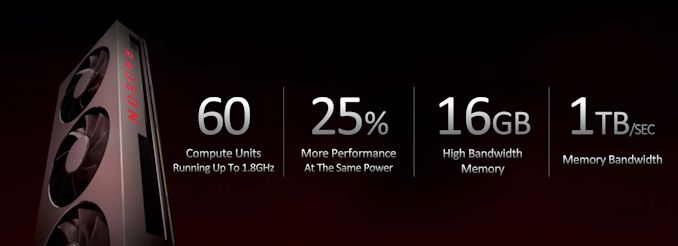

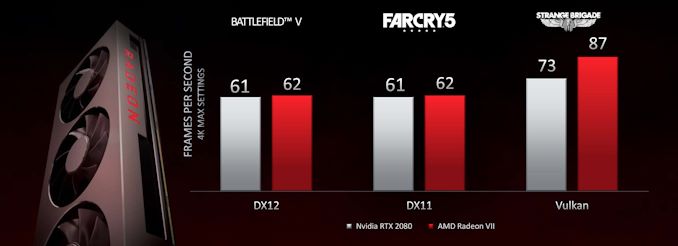
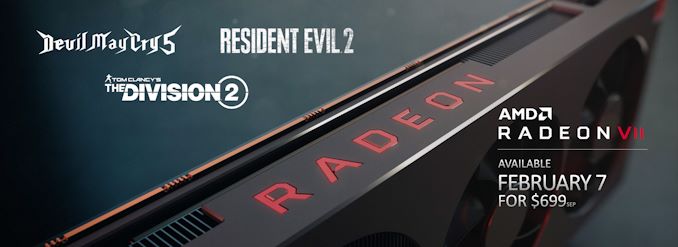
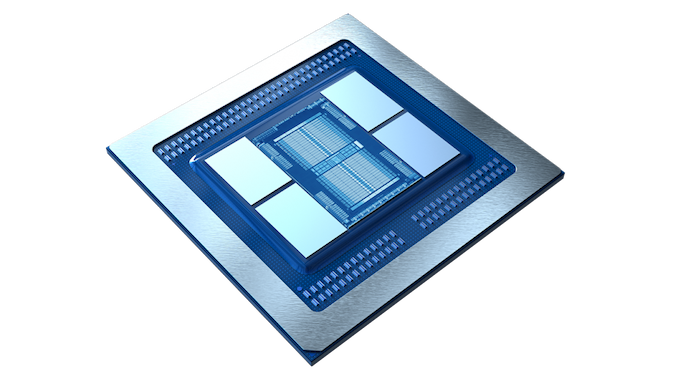








201 Comments
View All Comments
eastcoast_pete - Saturday, January 12, 2019 - link
Unfortunately (for AMD & fans), the Radeon VII has (only -?) 64 ROPs, so just like the Vega 64. That changes the value proposition, from exciting to so-so, at least at the launch price; it's now at least $ 100-150 too high. Still great for certain compute tasks, but, as it stands, not a 2080 GTX slayer anymore. Bummer! Nvidia could use a hard kick in the pants so they come down in price.eastcoast_pete - Friday, January 11, 2019 - link
Here another thought why AMD is coming out with this 16 GB HBM2 card now. I suspect AMD and several of its partner companies either have a lot of HBM2 silicon in stock or firmly ordered, something that happened before the Crypto-craze collapsed. Now, that HBM memory has to be shifted so it won't hang around their necks like a millstone. One good way to do so is be generous with HBM2 on a higher-end consumer card. They might even loose money on it, but nowhere near as much as if it just sits around. Cynical, I know.DillholeMcRib - Friday, January 11, 2019 - link
I'm not a huge graphics fanboy for either camp. That being said, this is embarrassing for $600 given the hype around 7nm and all that jazz. AMD should take a loss, undercut Nvidia @ $450 and wreck them. Lame move, AMD.del42sa - Saturday, January 12, 2019 - link
we know base clcok, why it is not in the chart ? Huh ?del42sa - Saturday, January 12, 2019 - link
your info about Vega ROP´s was edited ( in silence ) but not apologies for misleading information ?WhiteSkyMage - Saturday, January 12, 2019 - link
I will have to buy this GPU, no other choice. I can perhaps find a used 1080Ti but I have a FreeSync monitor and I am not sure how well it will work with NVIDIA. However, so far with Vega 64, it's good, but I need more performance for UWQHD+. I want to at least be in my FreeSync range (48-75FPS). I usually need to lower down some settings a notch to get around 50-60FPS at my resolution (3840x1600). I am guessing the Radeon VII can do the job with a Ryzen 9 @ 5.1 (if rumors hold true) and a fast B-die memory. I know it's made for compute and RTX 2080 is an equivalent with the RT & DLSS features, which BTW I don't plan to use even if the games that come out support it. I don't need RT at all...And besides, the RTX 2080 has some very aggressive power limit. I want a card that allows as much power so it can stretch its legs. I know that Radeon VII will consume a lot, but power consumption does NOT matter to me at all.noxlar - Sunday, January 13, 2019 - link
use vega 64 + radeon7 crossfire.. i'm running crossfire setup, been doing that for some years.. when software support crossfire it really fly's and never been unstable.. it's only when you force cf on software it isn meant to crossfire.. i don't game much, but know application have alot better support for crossfiresilverblue - Monday, January 14, 2019 - link
For those who haven't noticed, the Radeon VII actually comes with 64 ROPs. There's an article on ExtremeTech about it, here:https://www.extremetech.com/gaming/283649-the-amd-...
BigMamaInHouse - Monday, January 14, 2019 - link
What with the FP64? it turns out it indeed disabled on vega7!:https://techgage.com/news/radeon-vii-caps-fp64-per...
Questor - Wednesday, January 16, 2019 - link
"If AMD manages to reach RTX 2080 performance, then I expect this to be another case of where the two cards are tied on average but are anything but equal; there will be games where AMD falls behind, games where they do tie the RTX 2080, and then even some games they pull ahead in."Here is the problem with mind-share bias. Instead of wording this with a positive first, followed by the equal and ending with negative, we get what we see written here. Whether intended or not, it is giving an affirmation to Nvidia and placing AMD as an also ran wannabe. Even if they are, it is not unbiased journalism's job to tell us this. It is their job to present the facts and let the reader form his or her own opinion about these facts.
Anyone who believes AMD Radeon is across the board equal to Nvidia at this point in time is deluding themselves. That still doesn't account for journalistic mistreatment, whether intended or not, for products that do compete in/at whatever area/whatever level, be it price, performance, features, efficiency, price, any combination of or all.
A better way to have written this: If the Radeon VII reaches RTX 2080 performance, as testing has shown in the past, the competing cards will trade performance wins depending on the game title. There will games where the Radeon VII takes the win, games where they tie and games where the RTX 2080 wins.
I want competition. This will never happen if the tech press is always downplaying some brands and giving the nod to others, again, even if accidentally/unintentionally. It's indicative of the space Nvidia's owns (rent free I might add) in the mind of tech writers.